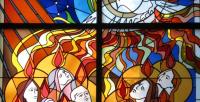
Luke uses powerful images of tongues of fire and a loud wind to describe the coming of he Holy Spirit. He wants to convey to his readers the drama of the occasion and the gift that has been given. The reading from Acts and the gospel extract from St John complement one another in that Jesus, having completed his work on earth, breathes the Holy Spirit into the apostles in order to inspire them to continue his teaching.
The Holy Spirit can be described as the love between the Father and the Son, the Third Person of the Trinity and a force so strong that it can change and direct the course of a person’s life as it did the apostles. It is this same Spirit which governed the early church and brought equality between Jews and Gentiles by descending on them both.
There is a sequence sung on Pentecost Sunday, Veni Sancte Spiritus. This is a liturgical hymn which dates back to the twelfth century. There are only five sequences used now, although the Dies Irae is not part of the requiem mass any more. Today’s sequence gives a beautiful description of the attributes of the Spirit: God the Holy Spirit is consoler, ”father of the poor”, a bringer of refreshing peace and a healer. Although the account of his coming is pictured with fire and wind, elements associated with violence, the Spirit’s presence is usually like a gentle breeze: he guides us to pursue paths which benefit us and add to the greater glory of God. He is the soul’s “delightful guest.”